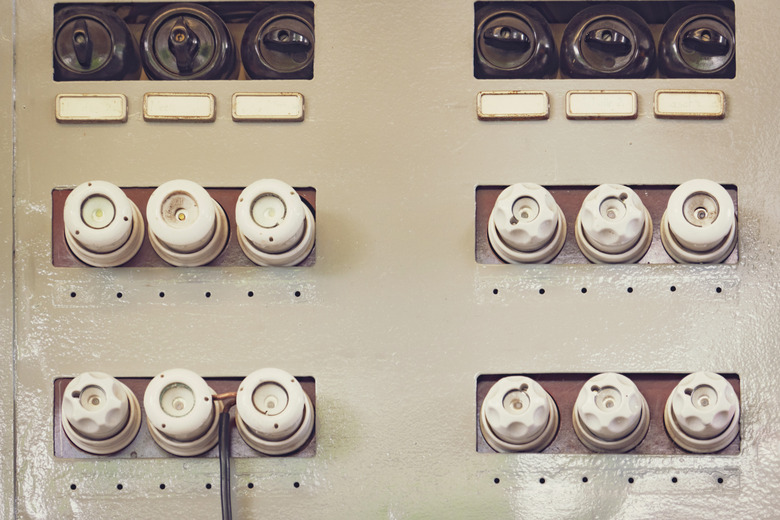How To Wire A 220 To A Fuse Box
The term "fuse box" is an anachronism. It refers to the electrical control centers in older houses that employed screw-in fuses that blew when the current draw exceeded their rating. If your house still has a fuse box — not a breaker box — you should hire an electrician to evaluate it before trying to connect a 220-volt outlet. There is no guarantee that the fuse box has a high enough amperage rating to handle it. Many older fuse boxes are rated for 60 amps and have only six connection slots. That's totally inadequate for most modern houses, even before adding a new circuit.
The electrician will probably recommend upgrading to a 100-or 200-amp breaker box. You may not want to hear that, but it's the safest option. If you must leave the fuse box in place, and the electrician determines that adding a 220-volt circuit is feasible, there are two options. One is to connect the wires to two available slots. If you have a six-slot fuse box, that means that only four are left for all the rest of your electrical needs. The second option is to install a sub-panel.
The Basics of Wiring a Fuse Panel
The Basics of Wiring a Fuse Panel
Because fuse boxes are all but obsolete, wiring them is becoming a lost art. The two hot legs from the line transformer, which have a voltage of 240 volts (220 is somewhat inaccurate) between them, connect to a pair of lugs, and a return wire leads back to the transformer. Each 110-volt circuit contacts one of these lugs and the return lug, but a 220-volt circuit must contact both hot lugs. To accomplish this, you must connect wires to a pair of fuses, and since they must be on different lugs, the fuses are usually on opposite sides of the fuse box.
Most fuse boxes have a cartridge containing larger 30-amp fuses to service a single 220-volt circuit. You can use this if it's available, but you can't exceed its current rating to power a large modern appliance, such as a 50-amp stove. An alternative would be to wire a subpanel to the fuse box and feed the new 220-volt circuit through it, but you should do this only after a thorough inspection and recommendation by a licensed electrician.
Breaker Boxes Are Easier and Safer
Breaker Boxes Are Easier and Safer
A breaker box makes 220-volt wiring a snap. Instead of lugs, the breaker box has a pair of bus bars, and the breakers are designed to snap onto them. The bars aren't straight. They squiggle like continuous S's so that each adjacent breaker contacts a different bus. That means that wires attached to a pair of breakers stacked together have a voltage of 240 volts between them.
To connect a 220-volt circuit, use one of these stacked breakers, also known as a double-pole breaker, with the amperage rating of the device you need to power. Each breaker accepts a hot wire, one of which is usually red and the other black. The neutral wire connects to the neutral bus, and the ground wire connects to the ground bus. That's four wires in all, so you need three-conductor cable. (The ground wire doesn't count as a conductor). The recommended wire gauge depends on the current rating. Use 12 AWG cable for 20-amp service, 10 AWG for 30 amps, 8 AWG for 40 amps and 6 AWG cable for 50-amp service.
Fuse Boxes Aren't Grounded
Fuse Boxes Aren't Grounded
The current electrical code requires all circuits, including 220-volt circuits, to be grounded, but older fuse boxes usually aren't. That's another compelling reason to upgrade the fuse box to a breaker box. Grounding helps prevent shocks and fires, and it protects sensitive equipment from damage. It isn't against the law to keep your old fuse box, but the law won't matter if you overload the fuse box with a new 220-volt circuit, and it overheats and burns down your house.
